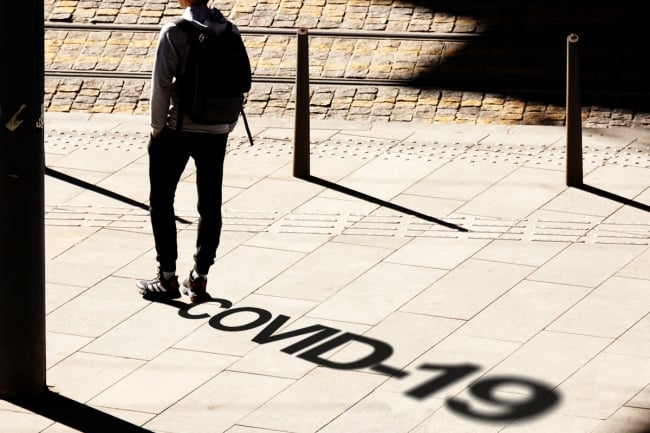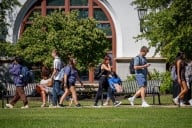You have /5 articles left.
Sign up for a free account or log in.

The long shadow of the pandemic could make admissions officers' jobs even more complicated this year.
Photo illustration by Justin Morrison/Inside Higher Ed | Getty Images
Admissions officers and application readers at Emory University will gather at the Atlanta campus next week for their first training session of the admissions cycle. The training will cover a number of new topics, including how to build a diverse class while complying with the Supreme Court’s ban on affirmative action and how to identify essays written by ChatGPT.
Another vexing challenge they face: how to assess the college readiness of applicants who started high school on Zoom during the pandemic, and whose education was disrupted to the point that it is hard to know how much they actually learned in secondary school.
“There isn’t a simple answer to that problem,” said John Latting, Emory’s dean of admission and assistant vice provost for undergraduate enrollment. “We’re just trying to get back to best practices on evaluating applicants, because it will be difficult.”
The extent of that problem is just becoming clear. Last week the ACT released its national average score for the class of 2023: a 19.5 out of 36, the lowest it’s been in over 30 years and the sixth consecutive year of decline. The most precipitous year-over-year ACT score decline came last year, when it fell from 20.3 to 19.8, dipping below 20 for the first time since 1991.
Ed Venit, managing director of EAB, the college marketing and enrollment service provider, said the ACT scores were “the first good data” he’s seen on the college preparedness of the pandemic generation—and it’s not reassuring.
“We’ve had data showing the learning loss among students age 13 and younger, and how much the pandemic set them back,” he said. “But these ACT scores are confirmation that we’ve already got a problem; it’s already here, and if these students aren’t already on campus they will be very soon.”
Even as test scores have plunged, the average high school grade point average has risen significantly, from 3.17 in 2010 to 3.39 in 2021—with the greatest inflation occurring between 2018 and 2021, according to a 2022 study from the ACT. That has made admissions offices less confident in the once-reliable metric of academic preparedness.
“We’re not as trusting, frankly, of GPA these days,” Latting said. “Students are trying their hardest … but grades are definitely inflated and not as connected to true class performance as they used to be.”
Yet they remain one of the few measures available to admissions officers; the vast majority of colleges that still required standardized tests in 2019 went test-optional during the pandemic. Standardized score submissions are way down at most institutions, leading to worries that assessing college readiness will be more difficult than ever this year.
Mark Schneider, director of the Institute of Education Sciences, an independent federal research center, describes a “perfect storm” of issues arising from the pandemic that complicates the task of identifying college-ready students.
“The academic and social skills of students applying to college have declined, that we know. We also don’t have standardized tests anymore really, and inflation makes grades pretty useless as a screening tool, too,” he said. “To use the technical term, it’s a mess.”
Staying Rigorous
For selective colleges and universities, ensuring applicants can handle academic rigor is a key part of the admissions process. Natasha Jankowski, the former executive director of the National Institute for Learning Outcomes Assessment, said admissions offices at most, if not all, of these institutions will “have to make some changes” to their usual applicant assessment methods to account for the pandemic’s effect on learning.
“The current tools are not going to have the same accuracy they once did to tell you, ‘Yes, this student is ready,’” she said.
Latting said Emory’s admissions office has retooled its rankings system for applicants, formally incorporating nontraditional measures such as creative output and educational opportunity for the first time this year. They’re also weighing “external assessment” more heavily than GPA, with a particular focus on AP scores.
And with fewer applicants choosing to submit standardized test scores, colleges are experimenting with ways to ensure they aren’t relying solely on GPA as a measure of aptitude.
Latting said there’s been a “subtle but persistent” increase in applications without test scores since Emory went test-optional in 2020. While the lack of a score doesn’t raise immediate alarm, he said, this year Emory admissions officers will be able to contact students who don’t submit an SAT or ACT score and encourage them to submit some piece of classwork they feel is representative of their academic interest and competency.
“We’re hoping that can give us more confidence to really lean into those applications and trust we’re making a good choice,” he said. “We just want to be able to fill in some blanks.”
But in the short term, the biggest challenge for institutions will be in culling the ever-growing crop of applications they receive to a manageable number of contenders. Latting said Emory receives roughly 33,000 applications a year, meaning each reader handles nearly 1,500. While there is no minimum GPA or test score cutoff, those metrics often helped with “triage;” now they may be harder to use.
“Admissions offices’ time-honored heuristics no longer apply,” Venit said.
Jankowski favors a shift toward more holistic assessment methods, such as having students submit self-tailored portfolios of classwork and extracurricular projects. That approach has yet to catch on among admissions officers; less than a quarter of respondents to Inside Higher Ed’s admissions survey this year said they’d favor student portfolios.
But Jankowski also said there are a “confluence of factors” that make innovating to solve the assessment problem difficult, not least of which is the Supreme Court ruling striking down race-conscious admissions. The less “objective” a measure appears to be, the more room there is for scrutinizers to point to it as a proxy for affirmative action, which was explicitly forbidden in Chief Justice John Roberts’ majority opinion.
An Admissions Problem With Attainment Consequences
Venit said selective institutions aren’t the ones that need to worry most; it’s the nonselectives—those that accept 80 to 90 percent of applicants and already admit students who might struggle with college-level coursework. If the more selective institutions have to water down their expectations for incoming students, the process will have an even more pronounced effect “down the selectivity ladder,” he said—especially for student success.
“The pandemic has broken a lot of our indicators, how we would normally assess how we're doing, particularly in the realm of student success, and it could lead to an expansion of the equity gap in terms of attainment if nothing is done,” he said. “Students are going to be coming into college with Swiss-cheese-style holes in learning that need to be filled.”
Wayne Fletcher, associate provost for academic services at California Baptist University, has seen this breakdown firsthand. Because of high school grade inflation during the pandemic, the admissions office, which is test-optional, hasn’t been able to properly identify students who need extra support before they arrive on campus, he said.
Before the pandemic they would slot those students—typically between 100 and 200—into student success classes to augment their transition to college. Now, because “high school GPAs have a tendency to be inflated post-COVID,” they catch far fewer on the way in, meaning more students fall behind in their first year. Fletcher said that last year only 15 students were identified for extra academic support.
“We know there are more there,” he said. “We just don't know where they are.”
Recent studies confirm that students themselves are aware they may have fallen behind, and that they’re more hesitant to apply to selective colleges—or in some cases, any college—because of it.
An ACT survey released in June asked current high schoolers whether the pandemic had influenced their thinking about college applications. Many said their experience with remote learning left them insecure about both their college admission prospects and their ability to succeed. A similar report from EAB found that 22 percent of surveyed high school students who said they weren’t likely to attend college were hesitant because they “are not mentally ready,” up from 14 percent in a similar study from 2019.
“That’s another problem, entirely different from academic preparedness; students have had social and emotional setbacks, too,” Jankowski said. “There aren’t a lot of admissions metrics to assess that kind of readiness right now.”
Venit said these problems are only likely to get worse as college applicants turn from those who attended high school remotely to those whose more crucial, vulnerable elementary and middle school years were disrupted.
The data support his thesis. The average scores of 13-year-olds on the National Assessment of Educational Progress declined four points in reading and nine points in math since the 2019–20 school year. Compared to 2012–13, they dropped seven points in reading and 14 points in mathematics.
“Higher ed institutions can’t just say OK, we’ll have to deal with this for a few classes and then things will even out,” Jankowski said. “That’s not going to happen.”









